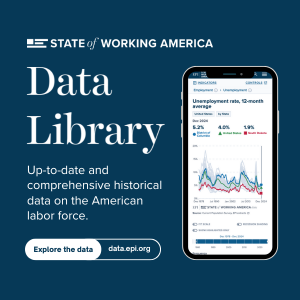Strengthening the EITC and raising the minimum wage should go hand-in-hand
Evan Soltas’ Friday column in Bloomberg misses some of the facts on the minimum wage, and presents a false choice between raising the minimum wage and expanding the Earned Income Tax Credit (EITC). The crux of his argument is that even though raising the minimum wage would reduce inequality, likely provide some stimulus to the economy, and help to reduce poverty, liberal policymakers should not pursue it because the EITC allegedly does all this more effectively, and Republican lawmakers might be less opposed to an EITC expansion than they are to raising the federal minimum wage. Questions of political acceptance aside, the reality is that these two policy levers need each other.
There’s a critical relationship between the minimum wage and the EITC that Soltas seems to be missing. In spoken comments at a conference last year, my colleague Heidi Shierholz explained [emphasis added]:
The U.S. has two main policies designed to address the problem of low wages – the minimum wage and the EITC. The minimum wage provides a floor for the wages people get in the market, and through the tax system; the EITC provides subsidies to workers who earn low wages. The real value of the minimum wage has been allowed to erode and needs to be raised. What about the EITC? It is now the largest program providing financial assistance to low-wage workers and their families. However, it is not a direct wage subsidy for all low-wage workers, because its value depends on how big your family is and your total family income. It has the greatest impact on the earnings of low-wage, single parents with children. In 2011, the maximum benefit was about $5,000 per year for a family with two children and a maximum income of about $40,000. That’s substantial. However, the maximum benefit was less than $500 for single people with no children and a maximum income of around $14,000. So if you are single and childless and work a full-time full-year minimum wage job, you make around $15,000 a year and you do not qualify for any EITC. And the problem is that the EITC may have a perverse impact on the wages of workers who do not qualify for it. Since it significantly raises the after-tax wages of many eligible low-wage workers, it may act to lower the before-tax wages paid by employers. So while the EITC more than compensates recipients for any decline in the wage employers pay, ineligible workers can be made worse-off by the existence of the program… And here’s another key point: this is also why the EITC and the minimum wage need each other, they work together. The EITC substantially raises the after-tax wages of eligible workers, and a higher minimum wage puts a floor under the wages of workers ineligible for the EITC and therefore limits the ability of employers to capture a big share of the total expenditure on the EITC.
So while the EITC may be hugely important for those that qualify, it does nothing for low-wage workers who are ineligible. And without an adequate wage floor, it may actually encourage employers to underpay their workers.
In regard to the targeting and efficiency of the minimum wage, EPI has repeatedly noted that most minimum-wage workers are not teenagers. The figures in the table below come from our analysis of Sen. Tom Harkin’s (D-Iowa) proposal to raise the minimum wage to $9.80. They show the demographic makeup of workers who currently earn a wage between $7.25 and $8.10 per hour—essentially the group that would be directly affected by any increase in the federal minimum wage. As the table shows, nearly 80 percent are at least 20 years old. Furthermore, more than half come from families with less than $40,000 in annual income. So while a portion of minimum wage workers are middle-class teens, it is misleading to paint the entire group of minimum-wage workers with this brush.

The idea that there is some cost-savings to be had from abandoning the minimum wage and focusing exclusively on the EITC is dubious for the reasons already described, but it also begs the question of cost savings for whom? Soltas is advocating that rather than requiring that businesses—in particular, some of the largest and most profitable companies in the country—should have to pay a barely-adequate wage to their employees, we should instead effectively subsidize these companies for their inadequate wages with increased publicly-funded tax credits.
I agree that the EITC should be expanded so that more single, non-parent workers qualify for benefits, but if policymakers truly want to fight poverty and combat the enormous growth in inequality in this country, continuing to let the minimum wage erode due to inflation is counterproductive. Trying to offset the income loss from this erosion through the EITC simply rewards employers for failing to pay their employees an adequate wage.
Enjoyed this post?
Sign up for EPI's newsletter so you never miss our research and insights on ways to make the economy work better for everyone.
